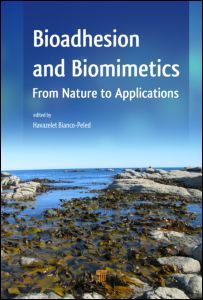Bioadhesion and Biomimetics From Nature to Applications
Coordonnateurs : Bianco-Peled Havazelet, Davidovich-Pinhas Maya

Bioadhesion is often defined as the state in which two materials, at least one of which is biological in nature, are held together for extended periods of time by interfacial forces. It is an area of active multidisciplinary research, where engineers, scientists?including chemists, physicists, biologists, and medical experts?materials? producers, and manufacturers combine their knowledge. From the practical point of view, bioadhesive systems have been used for several years for medical applications such as dentistry and orthopedics and are now entering new fields, for example, tissue sealing and directed drug delivery systems. Understanding bioadhesion mechanisms is of prime importance while exploring desired adhesion for bioadhesion applications such as sealants as well as successful prevention of undesired adhesion of biomolecules, cells, or organisms. Controlling the occurrence of bioadhesion events is also an important problem in the design and use of medical devices, biosensors, membranes, ships, and oil rigs.
This book provides a comprehensive view of bioadhesion and highlights different aspects of this phenomenon. The first section of the book presents fundamentals aspects of bioadhesion. It also summarizes various direct and indirect methods used to investigate and characterize bioadhesion. The second section describes studies of natural adhesives. These include "wet" adhesives that are produced and secreted by sessile marine organisms such as mussels and sand tubes and "dry" adhesives such as the one characterizing the gecko foot. The third section focuses on biomimetic adhesives. These man-made materials are fabricated on the basis of the lessons learned from nature emphasizing the correlation between nature understanding and biomimetics. Finally, the last section reviews medical applications of adhesive materials, which include surgical sealants, mucoadhesive drug delivery vehicles, and prevention of adhesion on medical devices.
Introduction. Principles of Bioadhesion. Characterization of Bioadhesion. Natural Adhesives. Mussel adhesives. Gecko adhesion. From Sand Tube to Test-Tube: The Adhesive Secretion from Sabellariid TubeWorms. Biomimetic Adhesives. Adhesives and Coatings Inspired by Mussel Adhesive Proteins. Algae mimetics. Bio-inspired surfaces with directional adhesion. Medical Applications. Surgical sealants. Bioadhesive systems for drug delivery. Preventing adhesion on medical devices.
Havazelet Bianco-Peled is an expert in the area of biomedical polymers and has received several awards for her professional accomplishments. She is the founder, CSO, and BOD member of SEAlantis Ltd., Israel, a company that develops, manufactures, and commercializes novel biomimetic tissue adhesives based on a technology invented in her lab. Prof. Bianco-Peled has authored more than 60 research publications and submitted 10 patent applications.
Maya Davidovich-Pinhas is a biochemical engineer who specializes in the development and analysis of mucoadhesive biomaterials. She received her PhD in chemical engineering from the Technion—Israel Institute of Technology, Israel. Dr. Davidovich-Pinhas has pioneered the use of acrylated polymers as a way to promote mucoadhesion in physiological environment. Such systems offer a novel approach for bioadhesion in order to control drug release and target drug delivery, which potentially improves its bioavailability.
Date de parution : 04-2015
15.2x22.9 cm
Disponible chez l'éditeur (délai d'approvisionnement : 15 jours).
Prix indicatif 160,25 €
Ajouter au panierThèmes de Bioadhesion and Biomimetics :
Mots-clés :
Mussel Adhesive Protein; mucoadhesive; Fibrin Glue; polymer; Mucoadhesive Polymers; dosage; Byssus Threads; form; Dosage Forms; adhesive; Delivery Systems; strength; Mucoadhesion Drug Delivery Systems; mussel; Biomimetic Adhesive; protein; Mucus Gel; drug; Polydopamine Coating; delivery; Fibrin Sealants; Gecko Adhesion; Ankaferd Blood Stopper; Mussel Adhesion; Byssal Plaque; Sandcastle Worms; Mussel Foot; Cement Discs; Mussel Byssus; Peel Angle; Energy Release Rate; Biofilm Formation; Mussel Proteins; Antifouling Polymers; Bacterial Adhesion



